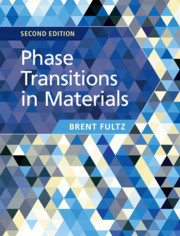Book contents
- Frontmatter
- Contents
- Preface
- Notation
- Part I Basic Thermodynamics and Kinetics of Phase Transformations
- Part II The Atomic Origins of Thermodynamics and Kinetics
- Part III Types of Phase Transformations
- 11 Thermodynamics and Phase Transitions at Surfaces
- 12 Melting
- 13 Solidification
- 14 Phase Transformations with Interfaces: 1. Microstructure
- 15 Phase Transformations with Interfaces: 2. Energetics and Kinetics
- 16 Spinodal Decomposition
- 17 Phase Field Theory
- 18 Method of Concentration Waves and Chemical Ordering
- 19 Diffusionless Transformations
- 20 Thermodynamics of Nanomaterials
- 21 Magnetic and Electronic Phase Transitions
- Further Reading
- References
- Index
20 - Thermodynamics of Nanomaterials
from Part III - Types of Phase Transformations
Published online by Cambridge University Press: 24 April 2020
- Frontmatter
- Contents
- Preface
- Notation
- Part I Basic Thermodynamics and Kinetics of Phase Transformations
- Part II The Atomic Origins of Thermodynamics and Kinetics
- Part III Types of Phase Transformations
- 11 Thermodynamics and Phase Transitions at Surfaces
- 12 Melting
- 13 Solidification
- 14 Phase Transformations with Interfaces: 1. Microstructure
- 15 Phase Transformations with Interfaces: 2. Energetics and Kinetics
- 16 Spinodal Decomposition
- 17 Phase Field Theory
- 18 Method of Concentration Waves and Chemical Ordering
- 19 Diffusionless Transformations
- 20 Thermodynamics of Nanomaterials
- 21 Magnetic and Electronic Phase Transitions
- Further Reading
- References
- Index
Summary
Here nanomaterials are defined as materials with structural features of approximately 10 nm or smaller, i.e., tens of atoms across. Unique physical properties of nanomaterials originate from one or two of their essential features: (1) nanomaterials have high surface-to-volume ratios, and a large fraction of atoms located at, or near, surfaces; (2) nanomaterials confine electrons, phonons, excitons, or polarons to relatively small volumes, altering their energies. Chapter 20 focuses on the thermodynamic functions of nanostructures that determine whether a nanostructure can be synthesized, or if a nanostructure is adequately stable at a modest temperature. The internal energy of nanomaterials is increased by the surfaces, interfaces, or large composition gradients. A nanostructured material generally has a higher entropy than bulk material, however, and at finite temperature the entropy contribution to the free energy can help to offset the higher internal energy term in the free energy F = E – TS. Chapter 20 discusses the structure of nanomaterials, the thermodynamics of interfaces in nanostructures, electron states in nanostructures, and the entropy of nanostructures.
Keywords
- Type
- Chapter
- Information
- Phase Transitions in Materials , pp. 511 - 532Publisher: Cambridge University PressPrint publication year: 2020

